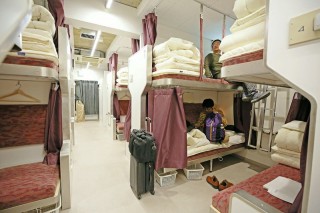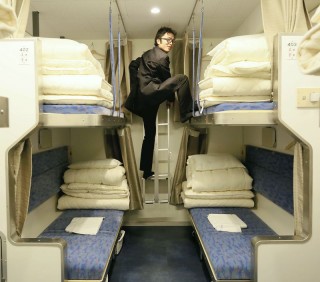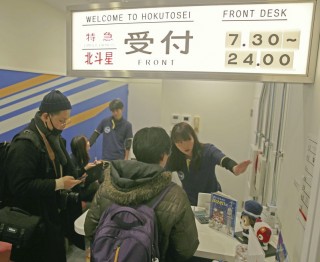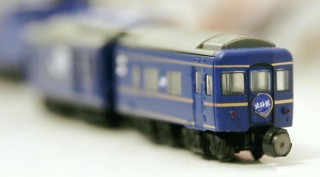Loading
Search
▼ Elements of Hokutosei Sleeper Train Revived as Tokyo Hostel
- Category:Stay
In 1988, the Hokutosei sleeper express was the first train to use the Seikan tunnel to link Ueno Station in Tokyo to Sapporo, over a journey of 1,200 kilometers. It gained popularity through such charms as luxury sleeping cars and a dining car where travelers could enjoy French-style cuisine. However, to the regret of many fans, in August 2015 the train service was completely discontinued due to the opening of the Hokkaido Shinkansen line and the aging of the Hokutosei train cars.
Last month, the Hokutosei was “revived” as a hostel in the Nihonbashi Bakurocho area of central Tokyo. Called Train Hostel Hokutosei, the hostel reuses train car equipment and has become a hot topic among railway enthusiasts who consider it a rebirth of their beloved sleeper express.
Last month, the Hokutosei was “revived” as a hostel in the Nihonbashi Bakurocho area of central Tokyo. Called Train Hostel Hokutosei, the hostel reuses train car equipment and has become a hot topic among railway enthusiasts who consider it a rebirth of their beloved sleeper express.
The hostel differs from ordinary accommodations, with large dormitory-type guest rooms shared by men and women on three floors and a large guest room exclusively for women on one floor. Its 38 bunk beds and two semiprivate rooms can accommodate up to 78 overnight guests. Restrooms, shower rooms and a kitchen are shared.
Many of the interior items, including the bunk beds, were previously used in the sleeper express.
Many of the interior items, including the bunk beds, were previously used in the sleeper express.
Signs bearing train car numbers are posted at the entrance to each of the large guest rooms. Reading lights installed beside the beds are the actual ones used in the sleeping cars. In addition, the door to the dining car has been reused as the hostel’s restroom door.
“I traveled on the Hokutosei train several times,” said a company employee in his 40s living in Itabashi Ward, Tokyo, who stayed at the hostel overnight. “Memories come flooding back at the smell and the feel of things here. I’d like to come again.
“I used to think I’d have a drink with my son, who’s now in elementary school, on board the sleeper express some day,” he said with a tinge of regret. “But the dream will have to stay a dream, and that’s too bad.”
Currently, even Hokutosei fans from nearby are said to be coming in large numbers to stay the night at the hostel.
“I traveled on the Hokutosei train several times,” said a company employee in his 40s living in Itabashi Ward, Tokyo, who stayed at the hostel overnight. “Memories come flooding back at the smell and the feel of things here. I’d like to come again.
“I used to think I’d have a drink with my son, who’s now in elementary school, on board the sleeper express some day,” he said with a tinge of regret. “But the dream will have to stay a dream, and that’s too bad.”
Currently, even Hokutosei fans from nearby are said to be coming in large numbers to stay the night at the hostel.
The idea for the Hokutosei hostel came from the East Japan Railway Co. group, one of the train’s operators, and a company in Chiba Prefecture whose business involves repurposing unused property as accommodation facilities and managing those facilities. They hoped to re-create the experience of a trip on the Hokutosei for businesspeople and foreign tourists looking to casually enjoy a long stay in Japan. Renovation work, which incorporated the sleeper express’ design concept of making the best use of limited space, was carried out in an existing seven-story building above the underground JR Bakurocho Station.
Accommodation fees vary depending on preferences, but largely go from about ¥2,500 to ¥4,000 per night.
Accommodation fees vary depending on preferences, but largely go from about ¥2,500 to ¥4,000 per night.
The Nihonbashi Bakurocho area is near the starting point of what were the Gokaido highways — the five major highways linking Edo, the current Tokyo, and regional areas during the Edo period (1603-1867). The area is said to have flourished as a town of hatagoya inns.
Recently, as the number of foreign tourists to Japan has rapidly risen, a growing number of accommodation facilities have emerged in the area to meet the needs of tourists seeking long-term stays at low rates.
(New Japan, Old Japan is a series exclusive to The Japan News)
https://youtu.be/YjPa9v6lWTU
Recently, as the number of foreign tourists to Japan has rapidly risen, a growing number of accommodation facilities have emerged in the area to meet the needs of tourists seeking long-term stays at low rates.
(New Japan, Old Japan is a series exclusive to The Japan News)
https://youtu.be/YjPa9v6lWTU
- January 24, 2017
- Comment (0)
- Trackback(0)






